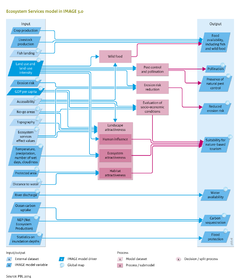Ecosystem services/Policy issues: Difference between revisions
Jump to navigation
Jump to search
m (RinekeOostenrijk moved page Ecosystem goods and services/Policy issues to Ecosystem services/Policy issues without leaving a redirect) |
No edit summary |
||
| Line 1: | Line 1: | ||
{{ComponentPolicyIssueTemplate | {{ComponentPolicyIssueTemplate | ||
|Description=Figure | |Description=Around the world, the number of services (out of the seven services food, water, Carbon sequestration, erosion protection, pollination, pest control, flood protection, tourism) sufficiently supplied differs strongly (Figure below) | ||
|Example= | |||
In a baseline, the proportion of people living in regions with sufficient supply of an ecosystem service is decreasing for most services in the future, except for food (Figure Policy interventions below). According to the scenario, sufficient food will be produced regionally, but unequal food distribution will still lead to malnutrition and hunger. Areas with sufficient supplies of ‘pest control, ’pollination’ and ’erosion protection’ are likely to decrease. Availability of water per person and the amount of carbon sequestrated relative to the amount emitted also decreases. | |||
|Example=As an example, the positive effect of one RIO+20 scenario (global technology scenario) on the sufficient delivery of most ecosystem services is presented in Figure below. The percentage of sufficient delivery increases compared to the baseline in 2050. The sustainability scenario focuses on limiting climate change, which is also illustrated by sufficient delivery of carbon sequestration. The sharp decline in water in the baseline 2050 is prevented in the global technology scenario. | |||
}} | }} | ||
Revision as of 08:05, 20 May 2014
Parts of Ecosystem services/Policy issues
| Component is implemented in: |
|
| Related IMAGE components |
| Projects/Applications |
| Key publications |
